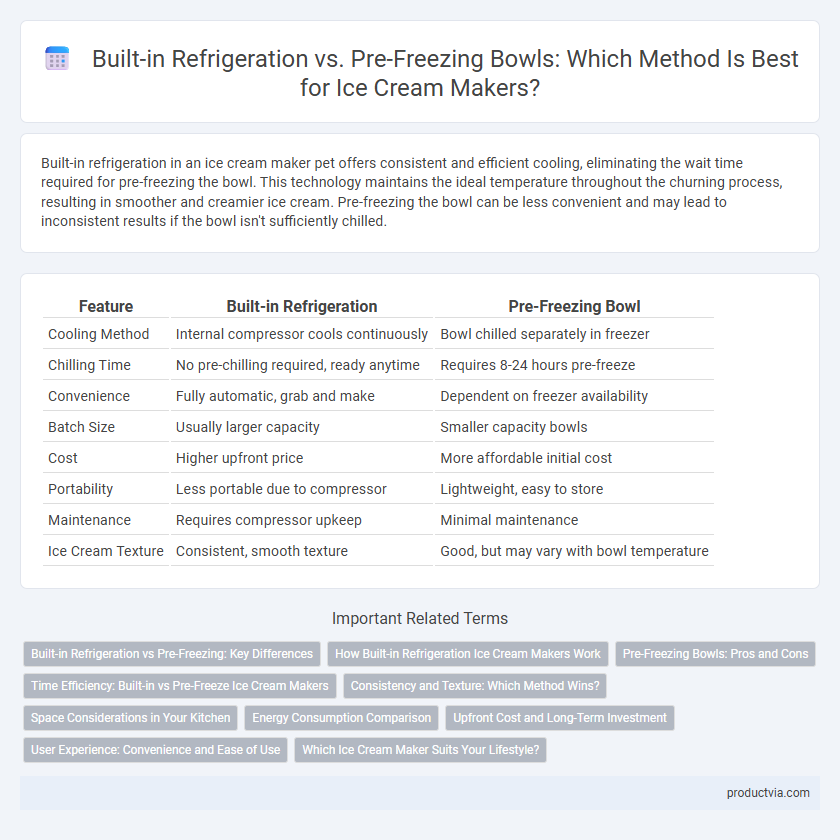Built-in refrigeration in an ice cream maker pet offers consistent and efficient cooling, eliminating the wait time required for pre-freezing the bowl. This technology maintains the ideal temperature throughout the churning process, resulting in smoother and creamier ice cream. Pre-freezing the bowl can be less convenient and may lead to inconsistent results if the bowl isn't sufficiently chilled.
Table of Comparison
| Feature | Built-in Refrigeration | Pre-Freezing Bowl |
|---|---|---|
| Cooling Method | Internal compressor cools continuously | Bowl chilled separately in freezer |
| Chilling Time | No pre-chilling required, ready anytime | Requires 8-24 hours pre-freeze |
| Convenience | Fully automatic, grab and make | Dependent on freezer availability |
| Batch Size | Usually larger capacity | Smaller capacity bowls |
| Cost | Higher upfront price | More affordable initial cost |
| Portability | Less portable due to compressor | Lightweight, easy to store |
| Maintenance | Requires compressor upkeep | Minimal maintenance |
| Ice Cream Texture | Consistent, smooth texture | Good, but may vary with bowl temperature |
Built-in Refrigeration vs Pre-Freezing: Key Differences
Built-in refrigeration ice cream makers feature an internal cooling system that continuously maintains optimal temperatures, allowing for immediate use without prior preparation. Pre-freezing models require the bowl to be frozen for 12 to 24 hours before making ice cream, which limits spontaneity and doubles preparation time. The built-in refrigeration system offers consistent cooling efficiency and convenience, while pre-freezing bowls are often more affordable but less flexible for frequent or last-minute use.
How Built-in Refrigeration Ice Cream Makers Work
Built-in refrigeration ice cream makers operate using an integrated compressor to continuously chill the mixing bowl, eliminating the need for pre-freezing. This technology maintains a consistent low temperature throughout the freezing process, ensuring smoother texture and faster ice cream production. By removing the wait time for bowl chilling, built-in refrigeration models offer greater convenience and efficiency compared to traditional pre-freeze bowl systems.
Pre-Freezing Bowls: Pros and Cons
Pre-freezing bowls in ice cream makers offers convenience by eliminating the need for built-in refrigeration components, making the machine more compact and affordable. However, pre-frozen bowls require advance preparation time and limited batch sizes due to the bowl's cooldown capacity. This method may result in inconsistent freezing performance if the bowl isn't adequately chilled before use.
Time Efficiency: Built-in vs Pre-Freeze Ice Cream Makers
Built-in refrigeration ice cream makers offer significant time efficiency by cooling the mixture directly during the churning process, eliminating the need for prolonged pre-freezing. Pre-freeze bowl models require up to 24 hours of freezing before use, which can delay preparation and reduce flexibility. Choosing built-in refrigeration systems streamlines ice cream production, enabling faster batch turnover and spontaneous dessert creation.
Consistency and Texture: Which Method Wins?
Built-in refrigeration in ice cream makers ensures consistent bowl temperature, resulting in smoother, creamier texture by preventing ice crystal formation during freezing. Pre-freezing requires advance planning and can lead to uneven chilling, causing inconsistent texture and potential ice crystallization. Consistency and texture favor built-in refrigeration systems for superior, restaurant-quality ice cream results.
Space Considerations in Your Kitchen
Built-in refrigeration ice cream makers offer continuous freezing capacity without needing to store a separate bowl in the freezer, saving valuable space. Pre-freezing bowls require ample freezer space to chill the bowl for several hours prior to use, which can be challenging in kitchens with limited freezer capacity. Choosing a built-in refrigeration model eliminates the need for freezer space dedicated to the bowl, optimizing kitchen layout and convenience.
Energy Consumption Comparison
Built-in refrigeration ice cream makers consume more electricity due to continuous cooling systems, delivering consistent chilling without user intervention. Pre-freezing bowl models require energy only during the freezer phase, making them more energy-efficient but dependent on freezer availability and extended preparation time. Choosing between these options impacts overall energy consumption, with built-in systems favoring convenience and pre-freezing models optimizing electricity use.
Upfront Cost and Long-Term Investment
Built-in refrigeration ice cream makers generally require a higher upfront cost due to advanced cooling technology but offer consistent performance and convenience without the need to pre-freeze bowls. Pre-freezing models have a lower initial price but demand freezer space and longer preparation time, which can be less efficient over long-term use. Investing in a built-in refrigeration system yields better durability and time savings, making it more cost-effective for frequent ice cream making.
User Experience: Convenience and Ease of Use
Built-in refrigeration ice cream makers offer superior convenience by eliminating the need to pre-freeze bowls, allowing users to start churning immediately. These machines provide consistent chilling throughout the process, enhancing the texture and quality of ice cream with minimal effort. In contrast, pre-freezing bowls require advance planning and freezer space, which can limit spontaneous use and add complexity to the ice cream-making experience.
Which Ice Cream Maker Suits Your Lifestyle?
Built-in refrigeration ice cream makers provide continuous cooling, allowing multiple batches without downtime, ideal for frequent or large-quantity users. Pre-freezing bowl machines require hours in the freezer before use, making them better suited for occasional use or limited counter space. Choosing between these depends on your cooking frequency, available storage, and desired convenience in ice cream preparation.
Built-in refrigeration vs pre-freezing for bowl chilling Infographic

 productvia.com
productvia.com